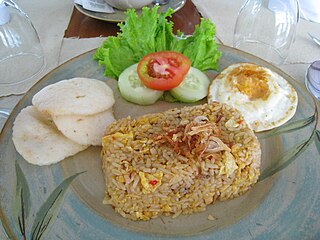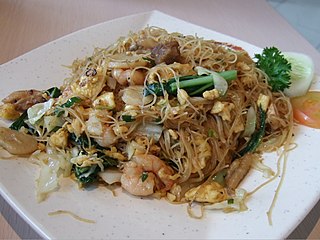
Nasi lemak is a dish originating in Malay cuisine that consists of fragrant rice cooked in coconut milk and pandan leaf. It is commonly found in Malaysia, where it is considered the national dish. It is also a native dish in neighbouring areas with significant ethnic Malay populations such as Singapore and Southern Thailand. In Indonesia, it can be found in several parts of Sumatra, especially the Malay regions of Riau, Riau Islands and Medan. It is considered an essential dish for a typical Malay-style breakfast. Nasi lemak is featured as a national dish in Malaysian tourism brochures and promotional materials.

Malay cuisine is the traditional food of the ethnic Malays of Southeast Asia, residing in modern-day Malaysia, Indonesia, Singapore, Brunei, Southern Thailand and the Philippines as well as Cocos Islands, Christmas Island, Sri Lanka and South Africa.

Fried rice is a dish of cooked rice that has been stir-fried in a wok or a frying pan and is usually mixed with other ingredients such as eggs, vegetables, seafood, or meat. It is often eaten by itself or as an accompaniment to another dish. Fried rice is a popular component of East Asian, Southeast Asian and certain South Asian cuisines, as well as a staple national dish of Indonesia. As a homemade dish, fried rice is typically made with ingredients left over from other dishes, leading to countless variations. Fried rice first developed during the Sui dynasty in China.

Murtabak, or Mutabbaq, is a stuffed pancake or pan-fried bread commonly found in the Arabian Peninsula, the Indian subcontinent, and Southeast Asia, notably in Saudi Arabia, Yemen, Indonesia, Malaysia, Singapore, Brunei, and Southern Thailand. Depending on the location, the name and ingredients can vary significantly. The name mutabbaq means "folded" in Arabic.

Tahu goreng or Tauhu goreng is a generic name for any type of fried tofu dish in the cuisines of Indonesia, Brunei, Malaysia and Singapore.

Nasi goreng, is a Southeast Asian rice dish with pieces of meat and vegetables added. It can refer simply to fried pre-cooked rice, a meal including stir-fried rice in a small amount of cooking oil or margarine, typically spiced with kecap manis, shallot, garlic, ground shrimp paste, tamarind and chilli and accompanied by other ingredients, particularly egg, chicken and prawns. There is also another kind of nasi goreng which is made with ikan asin which is also popular across Indonesia.

Fried noodles are common throughout East Asia, Southeast Asia and South Asia. Many varieties, cooking styles, and ingredients exist.

Omurice or omu-rice is a Japanese dish consisting of an omelette made with fried rice and thin, fried scrambled eggs, usually topped with ketchup. It is a popular dish also commonly cooked at home. Children in particular enjoy omurice. It is often featured in Japan's version of a children's meal, okosama-ranchi (お子様ランチ).

A banana fritter is a fritter made by deep frying battered banana or plantain in hot cooking oil. It is a common dish across Southeast Asia and South India.

Lontong is an Indonesian dish made of compressed rice cake in the form of a cylinder wrapped inside a banana leaf, commonly found in Indonesia, Malaysia, and Singapore. Rice is rolled inside a banana leaf and boiled, then cut into small cakes as a staple food replacement for steamed rice. The texture is similar to that of ketupat, with the difference being that the ketupat container is made from woven janur fronds, while lontong uses banana leaf instead.

Tumpeng is an Indonesian cone-shaped rice dish with side dishes of vegetables and meat originating from Javanese cuisine of Indonesia. Traditionally featured in the slamatan ceremony, the rice is made by using a cone-shaped woven bamboo container. The rice itself may be plain steamed rice, uduk rice, or yellow rice.

Nasi kuning, or sometimes called nasi kunyit, is an Indonesian fragrant rice dish cooked with coconut milk and turmeric, hence the name nasi kuning. Nasi kuning also can be found in neighbouring Malaysia, Brunei, Singapore and Cocos Island, Australia.

Lontong cap go meh is a Chinese Indonesian take on traditional Indonesian dishes, more precisely Javanese cuisine. It is lontong served with richly-flavoured dishes which include opor ayam chicken in coconut milk, sayur lodeh vegetable soup, hot and spicy liver, hard-boiled pindang egg, koya powder made of soy and dried shrimp or beef floss, pickles, chili paste and prawn cracker. Lontong cap go meh is usually consumed by the Chinese Indonesian community during the Cap go meh celebration.

Roti canai, or roti prata, also known as roti chanai and roti cane, is a flatbread dish of Indian origin found in several countries in Southeast Asia, especially Brunei, Indonesia, Malaysia, Singapore, and Thailand. It is usually served with dal or other types of curry but can also be cooked in a range of sweet or savoury variations made with different ingredients, such as meat, eggs, or cheese.

Nasi campur, also known as nasi rames or sego campur in Java, refers to an Indonesian and Malay dish of a scoop of nasi putih accompanied by small portions of several other dishes, which includes meats, vegetables, peanuts, eggs, and fried-shrimp krupuk.

Mamak stalls are indoor and open-air food establishments found in Southeast Asia, especially in Malaysia and Singapore, that typically serve food derived from Indian Muslim and Pakistani cuisines, unique to the region.

Nasi minyak is an Indonesian dish from Palembang cuisine of cooked rice with minyak samin (ghee) and spices. This rice dish is commonly associated with Palembang city, the capital of South Sumatra province. However, it is also common in neighboring Jambi as far north to Medan in North Sumatra. Nasi minyak looks and tastes similar to nasi kebuli, this is because both rice dishes are influenced by Indian and Middle Eastern cuisines, as evidence in the use of ghee and certain spices. Bumbu spice mixture being used including cardamom, anise, clove, caraway, cinnamon, onion, garlic and curry powder.

Nasi kari is an Indonesian rice dish from Acehnese, Minangkabau and Malay as well as Javanese cuisine. This rice dish is popular in Sumatra and Java, Indonesia.

Nasi goreng jawa is a Javanese-style of fried rice originated from Java, Indonesia. This dish can be found in Javanese cuisine and quite popular in Indonesia, especially Java. Commonly, this rice dish uses sambal ulek as seasoning and has a spicy taste.

Bihun goreng, bee hoon goreng or mee hoon goreng refers to a dish of fried noodles cooked with rice vermicelli in both the Indonesian and Malay languages. In certain countries, such as Singapore, the term goreng is occasionally substituted with its English equivalent for the name of the dish.





















